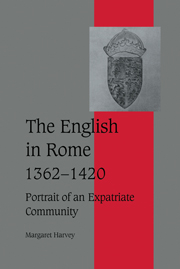Book contents
- Frontmatter
- Contents
- Acknowledgements
- List of abbreviations
- Maps
- Introduction
- 1 The setting I: Rome in the later fourteenth century, 1362–1376
- 2 The setting II: Rome, 1376–1420
- 3 S Thomas's hospice
- 4 S Chrysogonus' hospice and other enterprises
- 5 The laity in Rome
- 6 Women
- 7 The English in the curia 1378–1420: I
- 8 The English in the curia 1378–1420: II
- 9 The career of John Fraunceys
- 10 Adam Easton, an English cardinal: his career
- 11 Adam Easton's ideas and their sources
- 12 Conclusion
- Bibliography
- Index
- Cambridge Studies in Medieval Life and Thought Fourth Series
4 - S Chrysogonus' hospice and other enterprises
Published online by Cambridge University Press: 28 July 2009
- Frontmatter
- Contents
- Acknowledgements
- List of abbreviations
- Maps
- Introduction
- 1 The setting I: Rome in the later fourteenth century, 1362–1376
- 2 The setting II: Rome, 1376–1420
- 3 S Thomas's hospice
- 4 S Chrysogonus' hospice and other enterprises
- 5 The laity in Rome
- 6 Women
- 7 The English in the curia 1378–1420: I
- 8 The English in the curia 1378–1420: II
- 9 The career of John Fraunceys
- 10 Adam Easton, an English cardinal: his career
- 11 Adam Easton's ideas and their sources
- 12 Conclusion
- Bibliography
- Index
- Cambridge Studies in Medieval Life and Thought Fourth Series
Summary
The second English hospital which opened in Rome in the late fourteenth century was a product of the reign of Boniface IX and may even have been an aftermath of the 1390 Jubilee. It was largely the work of John White, a London merchant living in Rome, with his Gascon business partner Peter or Perrinus Baker and an Italian notary called Paolo dello Schocho but there seem to have been other local supporters in the Trastevere region where it was founded. The evidence suggests that this was a separate group, who knew the founders of S Thomas's but wanted their own work of charity.
The origins have been traced in the Sexcentenary edition of the house journal of the English College, in which the ‘foundation’ document was partially printed. According to this, in 1396 the canons of S Chrysogonus' church in Trastevere assembled and heard White say that for forty years they had had a two-storeyed house in Trastevere, in the parish of S Chrysogonus, called the hospital of S Chrysogonus, and next to it a house which Nicola Nelli Johannis Cinthii of Trastevere had caused to be re-roofed also for the use of the poor, with John's house next to that. These houses were threatened with ruin and John wanted to repair them and build a new storey and re-roof them, to make them bigger, as a hospital for the poor, for his soul and that of his relatives, so he asked the canons for permission.
- Type
- Chapter
- Information
- The English in Rome, 1362–1420Portrait of an Expatriate Community, pp. 77 - 90Publisher: Cambridge University PressPrint publication year: 2000



